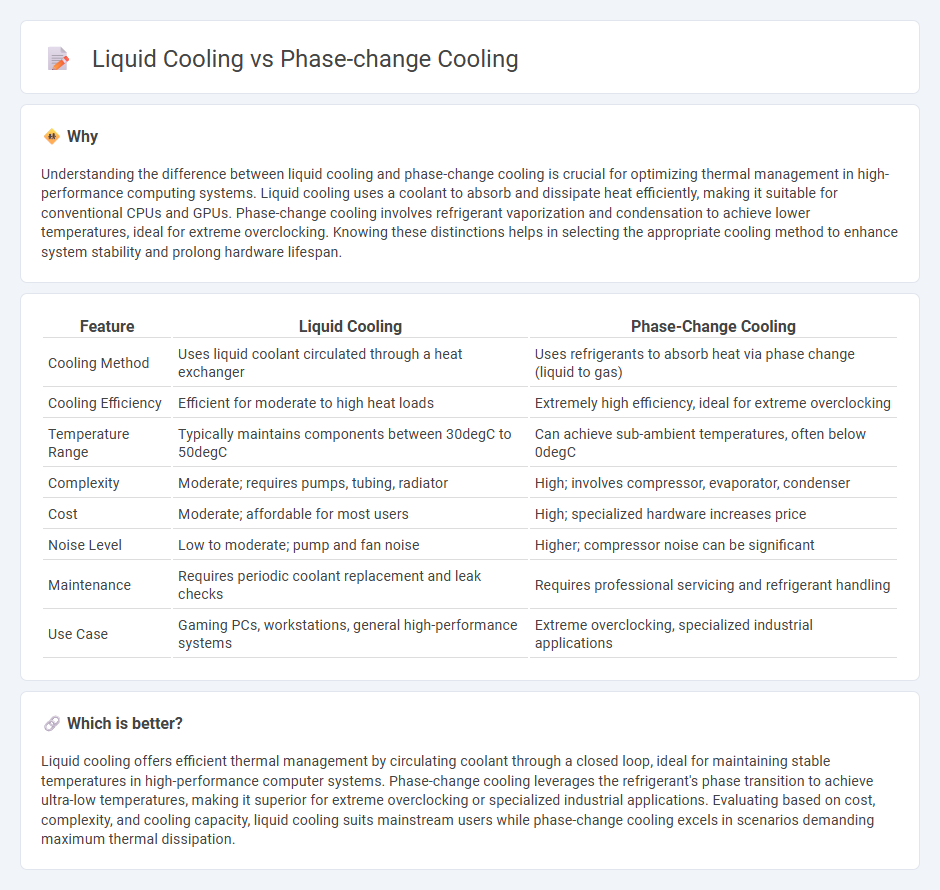
Liquid cooling systems use a coolant, typically water or specialized fluids, to absorb and dissipate heat efficiently from electronic components, offering quieter and more stable thermal management than air cooling. Phase-change cooling leverages the evaporation and condensation of a refrigerant to achieve extremely low temperatures, ideal for high-performance computing where maximum heat removal is critical. Explore the advantages and technical details of both liquid and phase-change cooling technologies to determine which suits your thermal management needs best.
Why it is important
Understanding the difference between liquid cooling and phase-change cooling is crucial for optimizing thermal management in high-performance computing systems. Liquid cooling uses a coolant to absorb and dissipate heat efficiently, making it suitable for conventional CPUs and GPUs. Phase-change cooling involves refrigerant vaporization and condensation to achieve lower temperatures, ideal for extreme overclocking. Knowing these distinctions helps in selecting the appropriate cooling method to enhance system stability and prolong hardware lifespan.
Comparison Table
| Feature | Liquid Cooling | Phase-Change Cooling |
|---|---|---|
| Cooling Method | Uses liquid coolant circulated through a heat exchanger | Uses refrigerants to absorb heat via phase change (liquid to gas) |
| Cooling Efficiency | Efficient for moderate to high heat loads | Extremely high efficiency, ideal for extreme overclocking |
| Temperature Range | Typically maintains components between 30degC to 50degC | Can achieve sub-ambient temperatures, often below 0degC |
| Complexity | Moderate; requires pumps, tubing, radiator | High; involves compressor, evaporator, condenser |
| Cost | Moderate; affordable for most users | High; specialized hardware increases price |
| Noise Level | Low to moderate; pump and fan noise | Higher; compressor noise can be significant |
| Maintenance | Requires periodic coolant replacement and leak checks | Requires professional servicing and refrigerant handling |
| Use Case | Gaming PCs, workstations, general high-performance systems | Extreme overclocking, specialized industrial applications |
Which is better?
Liquid cooling offers efficient thermal management by circulating coolant through a closed loop, ideal for maintaining stable temperatures in high-performance computer systems. Phase-change cooling leverages the refrigerant's phase transition to achieve ultra-low temperatures, making it superior for extreme overclocking or specialized industrial applications. Evaluating based on cost, complexity, and cooling capacity, liquid cooling suits mainstream users while phase-change cooling excels in scenarios demanding maximum thermal dissipation.
Connection
Liquid cooling and phase-change cooling both utilize the thermodynamic principles of heat transfer through phase transitions to efficiently dissipate heat from electronic components. Liquid cooling systems circulate a coolant, typically water or a specialized liquid, absorbing heat as it changes temperature, while phase-change cooling employs refrigerants that absorb heat by evaporating from liquid to gas, providing superior thermal management. Both methods enhance the performance and longevity of high-performance computing devices by maintaining optimal operating temperatures.
Key Terms
Latent Heat
Phase-change cooling exploits the high latent heat of vaporization to transfer heat efficiently by evaporating a refrigerant, creating a rapid phase change from liquid to gas, which absorbs significant thermal energy. Liquid cooling relies on circulating coolant fluids with lower latent heat capacities but uses convection to remove heat from components steadily, making it effective for sustained cooling needs. Explore more to understand how latent heat impacts cooling performance in high-power systems.
Coolant Circulation
Phase-change cooling utilizes a refrigerant that absorbs heat by changing state from liquid to gas, enabling highly efficient heat transfer during coolant circulation. Liquid cooling systems circulate a coolant such as water or glycol through pipes and radiators, relying on continuous fluid flow to dissipate heat from components. Explore detailed comparisons of coolant circulation mechanics and efficiency to choose the optimal cooling solution.
Heat Exchanger
Phase-change cooling uses a heat exchanger that exploits the latent heat of vaporization to rapidly transfer heat away from components, achieving superior thermal conductivity compared to traditional methods. Liquid cooling systems rely on heat exchangers that circulate coolant through tubes and radiators, efficiently dissipating heat via convection but often with lower thermal transfer rates. Explore the detailed mechanics and performance metrics of heat exchangers in phase-change and liquid cooling to optimize your thermal management strategy.
Source and External Links
Phase Change Cooling and Heat Transport Technologies - Phase-change cooling uses the latent heat of a coolant transitioning between liquid and gas phases, enabling efficient, high-capacity heat transfer with lower power consumption compared to traditional sensible heat methods like air or water cooling.
About Phase Change Cooling A Two-Phase Heat Transfer Technology - In phase-change cooling, a working fluid evaporates at the heat source, transports the vapor to a condenser, then returns as liquid via capillary action, continuously recycling within a closed loop to absorb and dissipate heat effectively.
Engineered Tough Safety Gear - MiraCool(r) Phase Change - MiraCool(r) phase-change cooling packs use a carbon-based liquid that absorbs heat as it melts at 14degC, providing several hours of cooling per activation and are reusable for personal or industrial applications.
 dowidth.com
dowidth.com